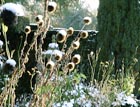Gardening tips for December
Order next year’s seeds, look after hyacinths, prune the apple trees and protect against rabbits


Order seeds
Be sure to order next year’s seeds in good time. If you had germination failures with direct sowing this year, it was probably more to do with our unpredictable weather than the fault of the seed. To help avoid such changeable conditions, sow some seed in modules at the normal sowing time, but keep them in a controlled environment. Or try varying the type, such as early and late. Some lettuces dislike hot, cold or dry conditions, for example, so use three or four different kinds at least one will be suited to the weather at the time. We find that our chickens much enjoy any lettuces that have bolted. We also grow as many as 16 varieties of potato for the same reason. This year, it was the blight-resistant ones such as Sarpo Axona and Sarpo Mira that were the most successful. Cooks beware at this time of year, they are very firm and cook irregularly, but with storage, they will mature and be delicious during February and March next year.
Look after hyacinths
It’s always a challenge to get your prepared hyacinths to flower for Christmas, but if you bought and planted them as soon as they were available, they should now be showing signs of growth. Keep them in a dark room with an even, cool temperature (we find the cellar ideal). Check and water them once a week. If you put them singly into 4in Jiffy coir pots, you can choose those growing at the same rate and pot them into pretty containers suitable for the house. If you have beehives, when the hyacinth flowers are tiring later on, put the plants out near the hives you’ll be surprised how the bees find and enjoy them on mild days. Then plant them out when they finish flowering, and they’ll come up again as normal spring-flowering hyacinths next year.
Prune apple trees
Prune your apple trees by the end of this month, or finish them off if you part-pruned them in the summer. Mature trees, pruned every year, should have all new growth cut back to an inch. Rambling old trees can be given a new lease of life, too. First, remove any dead or broken branches and any that cross over or spoil the main shape. Now, cut as much as one-third from all those remaining. If you do this for three years, the tree will become more manageable and then, if you continue with simple annual pruning, the fruiting laterals will grow again. (Shred as much of the thinner wood as possible, but if there are signs of canker, use it as a mulch away from any of your fruit trees. Thicker branches, when stored and dry, make wonderful firewood.)
Protect against rabbits
Exquisite houses, the beauty of Nature, and how to get the most from your life, straight to your inbox.
Protect your winter-planted shrubs and trees against the rabbits and hares that can invade the best-defended garden. Small, tender twigs tempt them, especially when sticking out of the snow. Make a simple circle of 2ft-high wire netting, fit it around the shrub or tree, and stake it to the ground with two or three canes. This system is less prone to wind damage than the plastic guards and is reusable for many years.
Country Life is unlike any other magazine: the only glossy weekly on the newsstand and the only magazine that has been guest-edited by His Majesty The King not once, but twice. It is a celebration of modern rural life and all its diverse joys and pleasures — that was first published in Queen Victoria's Diamond Jubilee year. Our eclectic mixture of witty and informative content — from the most up-to-date property news and commentary and a coveted glimpse inside some of the UK's best houses and gardens, to gardening, the arts and interior design, written by experts in their field — still cannot be found in print or online, anywhere else.
